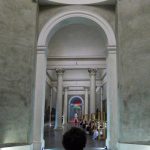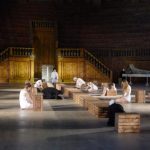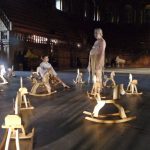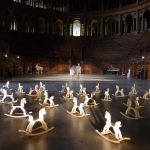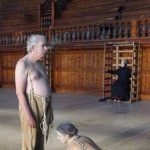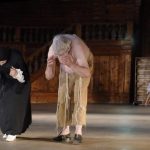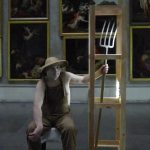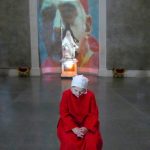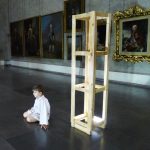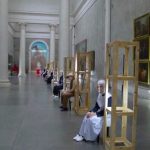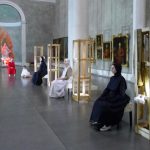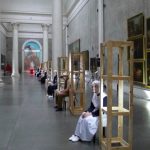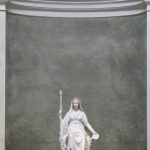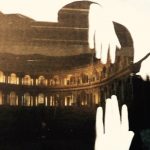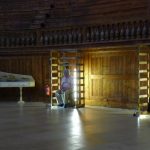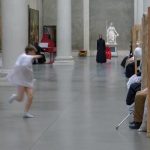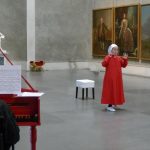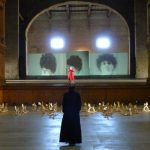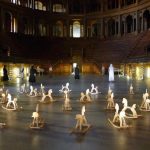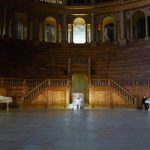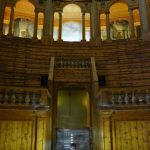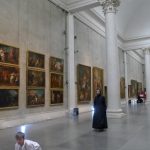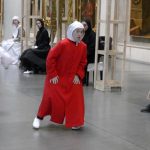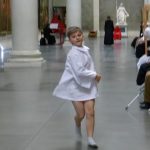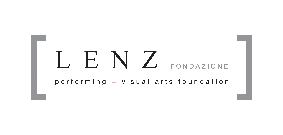
The Great Theater of the World
World Day of Social Justice
Per l’intera giornata del 20 febbraio sarà disponibile alla visione l’auto sacramental realizzato all’interno degli spazi espositivi del Complesso della Pilotta di Parma [+]
Prima parte del trittico The Imminent Past a partire dalle opere di Calderón de la Barca
The philosophical-theological baroque drama perfectly represents the thematic question that headlines the entire project: the imminent past. The Farnesian monument between the historical period and the contemporary, the dramaturgy that isolates life and dreams in the same space-time (and viceversa) and the relationship between urban space, collective fruition and active memory configure a hypothetical framework of synthesis and project for the capital of the future. The perception of individual time through multiple artistic forms (installation in space, video projected images, live performance, baroque musical dramaturgy, modern and contemporary) favorisce quel tempo comune – insieme allo spazio comune, la città – necessario a delineare identità comunitaria e nuove prospettive.
THE IMMINENT PAST Scrive Jean Luc Nancy: “L’arte chiamata contemporanea non è semplicemente quella che si può datare a oggi. È detta contemporanea perché essa non eredita alcuna forma né referenza. Non può essere l’arte del sacro né quella della gloria, né quella di una presunta natura o destino dei popoli. Essa eredita soltanto l’enigma portato da questa parola – ARTE – che fu inventata nel momento in cui cominciarono a sottrarsi tutte le figure di una possibile “rappresentazione”. Essa è contemporanea della propria erranza e della nascita sempre incerta e tremante di forme che sarebbero proprie di un incontro mancato di tutte le proprietà ricevute”. Pensiamo che il tempo del contemporaneo sia necessariamente discontinuo, l’artista contemporaneo aggiunge, divide, toglie, sostituisce il proprio tempo, lo “sente” nell’intimo, lo mette in relazione con altri tempi, sprofonda nel passato e si tende al futuro. “Nel contemporaneo tutto deve ancora accadere. E insieme è già accaduto” come riflette acuto Marco Belpoliti. E quel che accade è il presente, our present. Se poi la fisica moderna – soprattutto quantistica – tende ad escludere l’esistenza del Tempo, e ci comunica che l’attimo che viene non è uguale all’attimo che lo precede, e che non c’è linearità ma solo movimento concentrico di atomi che si spostano nello spazio, e che la sensazione è solo soggettiva e solo determinata dal movimento allora la nostra ricerca ha qualche fondamento. Il continuo rifrangersi nell’opera classica, sia essa letteraria o poetica o visiva, diventa perciò, per noi prassi linguistica, costante nella ricerca estetica, nella metamorfosi di forme e di segni, nel ripetersi della Storia; indagine errante e incerta, balbuziente avrebbe scritto Paul Celan. Come il Tempo dell’infinitamente grande e dell’infinitamente piccolo. The Great Theater of the World, è stato realizzato in collaborazione con il Complesso Monumentale della Pilotta. La messa in scena de The life is dream by Pedro Calderón de La Barca, prima in forma di auto sacramental contemporaneo e poi nella messa in scena del dramma in tutti gli spazi del complesso, hanno costituito il progetto triennale 2018-2020. The Great Theater of the World Dramaturgy, imagoturgy Francesco Pititto Giuseppe Distefano, Artribute, 2 July 2018 It arouses a whirlwind of emotions. Physics, mental, spiritual. And of visions, which open the gaze and solicit resonances of memories and words, of places and stories, of past and present. Between dizziness of light and shadow, touches the heart and mind. It envelops us and involves us, spatially and internally, like a big hug that contains everyone and everything Once again Lenz animates the hidden and unconfessed of the place and makes it the main source of light […] For Pititto and Maestri the Farnesian monument is the dramaturgy that encloses life and dreams in the same space-time, between historical period and contemporaneity, individual enjoyment and collective memory. An encyclopedic embrace of differences, of the possibilities of the human being. With eyes closed wide open. It is a show that is at times moving and at times funny in its paradoxes and the replication of age-old patterns, in the irony of fate, in the roulette of roles […] And it's truly thrilling to be able to enter these spaces outside of opening hours, glimpse paintings “burned” by the headlights that illuminate the actors' positions and discover very strong shadows, watching characters so convincing that they seem to have materialized out of these oils on canvas after almost 400 years. A vision capable of drying up the baroque charms of the literary place from which it originates, as of the physical place where it took new shape, to give us an alienated dramaturgical evocation in whose interstices, between variegated and reiterating visual projections, the sharp interventions of the sound compositions and electronic reworkings of Claudio Rocchetti flashed, with the alienating counterpoint of the various harpsichords scattered throughout the stage space. Lenz, while preferring aesthetic research, is characterized by a rigorous political connotation, etymologically speaking, which abandons the spectacularization of theater for tours and large audiences to reactivate the history of abandoned places, of outcast humanity, of the neglected tradition, without however waving the flag of urban regeneration, of social theater or the updating of the classics. Pititto and Maestri propose the distortion of a metatheater as a gravitational space in which individuals are structured as elementary particles, whose motion is constant, casual and necessarily led to the meeting/clash, and whose narrative is not flat and continuous, ma formata dall’interazione e solo esclusivamente per suo tramite. A directorial-dramaturgical practice that manages to create a synthesis of disturbing beauty, as oriented by the alchemistic instinct of “a union of opposites”, in a release of occult energies, latent […] This work by Calderón-Pititto is a theatrical thought of sacred and simple solemnity, which regulates the entrance of the actors on stage with the opening of two doors: the cradle and the grave. Calderón de la Barca makes the dream dimension a path of moral purification. Pititto and Maestri use it to propose a thought similar to that which Polonius formulates observing Hamlet's "madness": There is method in the madness that is our existence. An event of extreme expressive refinement on an ideational and implementation level, three main stages, "stations" of knowledge as in a sacred representation […] superb multiplication of theater within theatre.
Auto sacramental contemporaneo
Installation, composition, wrappers Maria Federica Masters
Interpreters Barbara Voghera, Paolo Maccini, Franck Berzieri, Carlotta Spaggiari, Valeria Meggi, Matthew Castellazzi, Sandra Soncini, Lara Bonvini, Valentina Barbarini, Lorenzo Davini, Monica Bianchi and Eugenio Degiacomi (basso)
Musicians Sarah Ten, Alessandro Trapasso, Luciano D'Orazio, Alessio Zanfardino, Francesco Monica and Francesco Melani
Musical direction of the harpsichordists Maestro Francesco Baroni
Electronic musical composition and re-elaboration Claudius Rocchetti
Planning and organizational care Elena Sorbi, Ilaria Stocchi
Communication, Press office Michele Pascarella
Technical care Alice Scartapacchio
Media video Stephen Cacciani
Production Lenz Foundation
Project created in collaboration with:
Pilotta Monumental Complex, con il sostegno di AUSL Parma – DAI SM-DP, dell’Instituto Cervantes de Milán e con il contributo di MiBACT Ministero dei Beni delle Attività Culturali e del Turismo, Emilia Romagna region, Municipality of Parma, Cariparma Foundation, Monteparma Foundation. Partner artistici: Conservatorio di Musica Arrigo Boito di Parma e Associazione Ars Canto G. Verdi Coro Voci Bianche e Coro Giovanile. Partner tecnici: AuroraDomus Cooperativa Sociale O.N.L.U.S, Koppel A.W..
Il progetto è parte integrante di EnERgie Diffuse Emilia-Romagna un patrimonio di culture e umanità e 1618-2018 Quattrocento anni del Teatro Farnese di Parma, manifestazioni insignite del marchio dell’Anno europeo del patrimonio culturale 2018.
Matteo Brighenti, Double zero, 28 June 2018
Matteo Bergamini, Exibart, 25 June 2018
Alessandro Rigolli, Music Journal, 26 June 2018
Giulio Sleep, Paper Street, 14 July 2018
Daniele Rizzo, Persinsala, 29 June 2018
Franco Acquaviva, Curtain, 2 July 2018
Enrico Piergiacomi, Theater and Criticism, 16 July 2018
Valeria Ottolenghi, The Gazzetta di Parma, 21 June 2018







